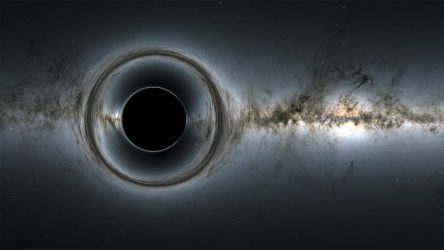 If there is any other kind of celestial object that is capable of generating as much curiosity and wonder as a black hole, then I don’t know what it could be. Whenever I do just about any kind of astronomy outreach, with any age group, there is bound to be a question or two about black holes (although questions about the existence of aliens proves rather popular too). And I can relate to the enthusiasm folks have for these mind-boggling creations of Nature. At the mere mention of black holes, I become all giddy and will likely talk your ear off about them. In fact, a friend of mine has jokingly suggested that I should become equipped with a sign around my neck that says something to the following effect:
If there is any other kind of celestial object that is capable of generating as much curiosity and wonder as a black hole, then I don’t know what it could be. Whenever I do just about any kind of astronomy outreach, with any age group, there is bound to be a question or two about black holes (although questions about the existence of aliens proves rather popular too). And I can relate to the enthusiasm folks have for these mind-boggling creations of Nature. At the mere mention of black holes, I become all giddy and will likely talk your ear off about them. In fact, a friend of mine has jokingly suggested that I should become equipped with a sign around my neck that says something to the following effect: 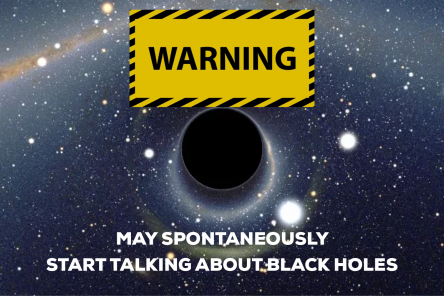
At least I think he’s joking. On second thought, he’s really not that good of a friend to begin with so who cares what he thinks, right? Anyways, in this month’s blog, I want to tell you about black holes, what they are, how we know what we know about them, and where to look in the summer sky for the general areas in which two well known black holes are located. Obviously, by their very nature, black holes cannot be seen directly but it’s kinda cool to be able to point to an area upon the sky and say to yourself, “Yeah, THAT’S where a black hole is lurking right this very moment.” The coolness factor that comes from this month’s Night Sky blog entry is not from the actual “seeing” but in the “knowing”.
THE NATURAL HISTORY OF BLACK HOLES
A simplified working definition of a black hole is that it’s a region of space where matter has become so incredibly dense, and compressed into such a miniscule volume, that any object straying within a certain limit, cannot escape its gravitational pull. Not even light. With the first sentence of this article, I referred to black holes as being objects and here I just said that black holes are more a “region of space”. In using the word “object” there is the implication that we are dealing with a solid body of some kind with a surface, like, say, a rocky planet. But black holes are definitely not an object in the classical sense. In the words of astronomer Janna Levin, 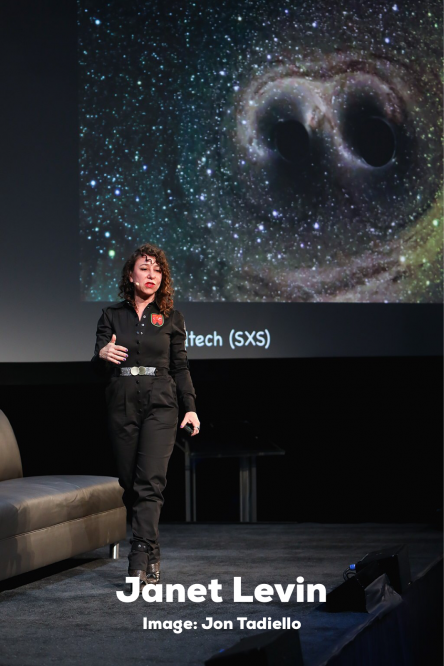 in her excellent book, “The Black Hole Survival Guide”: “Black holes are nothing. Black holes are special because there’s nothing there. There is no thing there.” How can nothing be a something with enough gravity to hold on to light, the fastest thing in the universe? For that matter, how can it wield any kind of gravitational influence upon something so seemingly insubstantial as light? Black holes have a way of making our puny primate brains go into conniptions in trying to understand them. They defy all our intuitive sense about reality and, well, they are just downright weird. In order to wrap our heads around what a black hole truly is, it will be helpful if we first talk a bit about gravity and how fast something needs to be moving in order to escape its influence.
in her excellent book, “The Black Hole Survival Guide”: “Black holes are nothing. Black holes are special because there’s nothing there. There is no thing there.” How can nothing be a something with enough gravity to hold on to light, the fastest thing in the universe? For that matter, how can it wield any kind of gravitational influence upon something so seemingly insubstantial as light? Black holes have a way of making our puny primate brains go into conniptions in trying to understand them. They defy all our intuitive sense about reality and, well, they are just downright weird. In order to wrap our heads around what a black hole truly is, it will be helpful if we first talk a bit about gravity and how fast something needs to be moving in order to escape its influence.
In the year 1687, Sir Isaac Newton published his three-volume masterwork, “Principia”, 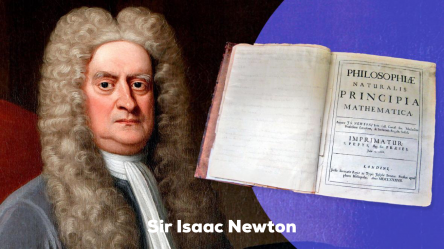 where he lays out his laws of motion and his law of universal gravitation. According to Newton, gravity is a force of attraction between objects due to their masses. With enough mass, an object’s gravity can change the motion of another object by altering its direction, speed, or both. On top of that, Newton says that gravity is not just an attraction between an apple and the Earth but that it is an attraction that exists between all objects, everywhere in the universe. Gravity’s effect extends from every object out into space in all directions, and for an infinite distance. While its effects are boundless, it does weaken with distance as you move further and further away from a gravitational source. But how do you break free of its grip when you are close to that source?
where he lays out his laws of motion and his law of universal gravitation. According to Newton, gravity is a force of attraction between objects due to their masses. With enough mass, an object’s gravity can change the motion of another object by altering its direction, speed, or both. On top of that, Newton says that gravity is not just an attraction between an apple and the Earth but that it is an attraction that exists between all objects, everywhere in the universe. Gravity’s effect extends from every object out into space in all directions, and for an infinite distance. While its effects are boundless, it does weaken with distance as you move further and further away from a gravitational source. But how do you break free of its grip when you are close to that source?
Imagine you are standing on the Earth, and you’ve got a ball in your hand. You throw the ball upwards and, just as you expect, it comes right back down again. You throw it into the air again, but you add a little more “oomph” to it. This time the ball goes up higher, slows and then falls back to the ground again. Let’s say that you do this a third time, but you add a bit more special “oomph” to your throw. This time, the ball just keeps going and never falls back to the Earth. The technical term for your “special oomph” is “escape velocity”  (if you want to talk like a rocket scientist) and it is the speed that an object must attain in order for it to break free of the gravitational influence of another body.
(if you want to talk like a rocket scientist) and it is the speed that an object must attain in order for it to break free of the gravitational influence of another body.
The two most important factors when considering an object’s escape velocity are a) the object’s mass and b) the distance to the object’s center. It’s a rather straightforward calculation that most high school physics students are taught using the formula v escape = 2𝐺𝑀𝑅‾‾‾‾‾√, where G= the gravitational constant (its numerical value is 6.67 × 10-11 Newtons kg-2 m2), M is the object’s mass, and R is the object’s radius. 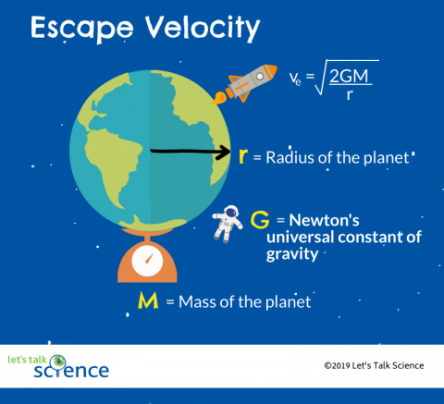 Once you do all the math, it turns out that the escape velocity of the Earth is 11.2 km/second. That’s how fast you must accelerate a rocket, a ball, or someone you don’t like in order to get them out of Earth’s gravitational grip and on their merry way into space.
Once you do all the math, it turns out that the escape velocity of the Earth is 11.2 km/second. That’s how fast you must accelerate a rocket, a ball, or someone you don’t like in order to get them out of Earth’s gravitational grip and on their merry way into space.
Let’s say that the Earth was not as big as it is. Let’s say that this make-believe Earth has all the mass of the real one but only half the diameter. What’s the escape velocity now? Turns out to be 15.8 km/second. Why is the escape velocity greater, even though the size is smaller? Well, it’s because we kept all of that mass inside a smaller body, making the make-believe Earth much denser. When you decrease the diameter of an object and keep all the mass, you are much closer now to that object’s center of mass while standing on it’s surface and the gravity scales up in such situations.
We can go even more extreme than this. If you could compress the make-believe Earth down even smaller, say, to an object that is now 9mm in diameter, while still keeping all of the mass, the escape velocity would be the speed of light, 299,472 km/second. Shrink it down a smidge more and the escape velocity exceeds the speed of light. Either way, if you get trapped in the gravitational grip of such an object, you aren’t going anywhere, ever, because nothing in the universe can travel faster than light can. If you’ve been paying attention, you are probably asking yourself, “if photons of light do not have mass, then how can gravity have any effect on them no matter what the escape velocity is?” To answer that, we must recognize that so far, we’ve not been dealing with a complete picture of gravity.  To resolve this issue, we must turn to Albert Einstein and his version of gravity as revealed to us in the theory of general relativity (GR).
To resolve this issue, we must turn to Albert Einstein and his version of gravity as revealed to us in the theory of general relativity (GR).
General relativity states that gravity, rather than being a force of attraction, is actually the direct result of space becoming distorted by massive objects. We won’t go into how he arrived at this startling revelation but suffice to say, it was the great man’s crowning achievement in an already illustrious career. Einstein tells us that both space and time are an interwoven, flexible fabric called, shockingly enough, “spacetime”. 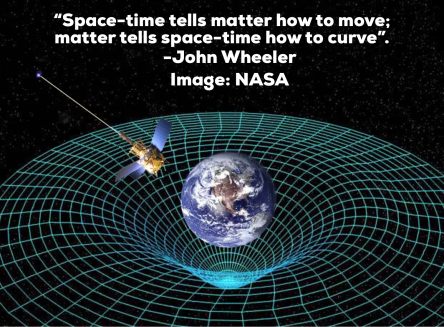 When massive bodies like stars, planets, moons, or black holes interact with spacetime, they create depressions in it. These depressions in spacetime are called “gravity wells”, which then draw nearby objects into orbit around them. As kooky as it may sound, it’s quite real and verifiable. In fact, it’s been verified over an over again with countless tests for well over 100 years now and it is now our modern understanding of how gravity works. As American physicist John Wheeler (who also coined the name, “black hole”) has said, “Space-time tells matter how to move; matter tells space-time how to curve.”
When massive bodies like stars, planets, moons, or black holes interact with spacetime, they create depressions in it. These depressions in spacetime are called “gravity wells”, which then draw nearby objects into orbit around them. As kooky as it may sound, it’s quite real and verifiable. In fact, it’s been verified over an over again with countless tests for well over 100 years now and it is now our modern understanding of how gravity works. As American physicist John Wheeler (who also coined the name, “black hole”) has said, “Space-time tells matter how to move; matter tells space-time how to curve.”
And here at last is our explanation for why light, or anything else, cannot escape from the grip of a black hole once it gets caught in a gravity well. Light wants to travel in a straight line. Black holes, being such incredibly dense, compact objects, create gravity wells so deep, that any light or matter that gets funneled into it plunges over an abyss with sides so steep, nothing ever gets back out. Ever. Kids, this is why you should never play near a black hole. Also note, black holes do not suck things into them like cosmic vacuum cleaners, gravity just doesn’t work that way. Also note that because light cannot escape, we say these things are “black”.
Black holes did not immediately leap out of Einstein’s complex mathematical equations describing GR, but they did emerge pretty quickly and not from Einstein. Shortly after he published his theory of general relativity,  he received a letter from a German astronomer named Karl Schwarzschild, saying that he had solved the equations and that, buried deep in all the math, was something rather curious. Schwarzschild told Einstein that, using his field equations, it was possible, at least mathematically, to have a very dense, compact object, where, if other objects fell into their gravity well, they wouldn’t fall back out again. He even calculated a spherical zone around such a hypothetical object from which light itself would become forever trapped. It was at this point that we have the first theoretical model for our modern concept of black holes. This no trespassing, spherical region around these objects is now called the “Schwarzschild Radius”. It’s also called the “event horizon”, because information about any event happening beyond that “horizon” can never reach those of us on this side of it. Crazier still, beyond this point, Einstein’s math breaks down entirely. Or so it would seem. Work the equations and it says that all matter beyond the event horizon gets crushed down to an infinitely small point that we call a “singularity”. Anytime your math tells you that you have arrived at an infinity, it means that your understanding of whatever it is you are trying to describe is not yet complete.
he received a letter from a German astronomer named Karl Schwarzschild, saying that he had solved the equations and that, buried deep in all the math, was something rather curious. Schwarzschild told Einstein that, using his field equations, it was possible, at least mathematically, to have a very dense, compact object, where, if other objects fell into their gravity well, they wouldn’t fall back out again. He even calculated a spherical zone around such a hypothetical object from which light itself would become forever trapped. It was at this point that we have the first theoretical model for our modern concept of black holes. This no trespassing, spherical region around these objects is now called the “Schwarzschild Radius”. It’s also called the “event horizon”, because information about any event happening beyond that “horizon” can never reach those of us on this side of it. Crazier still, beyond this point, Einstein’s math breaks down entirely. Or so it would seem. Work the equations and it says that all matter beyond the event horizon gets crushed down to an infinitely small point that we call a “singularity”. Anytime your math tells you that you have arrived at an infinity, it means that your understanding of whatever it is you are trying to describe is not yet complete.
Einstein himself dismissed all of this nonsense as just taking the math too far. He firmly believed that nature would have some way that would prevent all of those atoms comprising the mass of an object from ever being crushed down to a point where an object like a black hole would ever form, let alone to an infinitely small point. Nope, Einstein reasoned, nature would just not let a lot of matter be crushed into nothingness, leaving behind such a weird monstrosity of gravity. It just all sounded so gosh darn crazy. So, for many decades, the concept of black holes languished as mere mathematical oddities, fodder for science fiction perhaps, but not for real science. 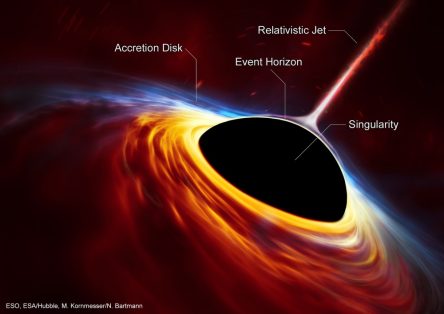 To cut this already long story short, physicists began to understand that yes, nature could find a way that would allow matter to get crushed right out of existence and leave behind a black hole: the catastrophic core collapse of massive stars. For most stars, death arrives when the core runs out of fusible material and gravity does crush the core down to something smaller. But, at the quantum level, nature has a built-in safety mechanism that keeps gravity from crushing it right out of existence. Not so with dead stellar cores with 3x or more the mass of the Sun. In such situations, there is no stopping gravity and matter can in fact get squeezed down into nothingness. But how could we find the evidence? How could we see what is, by definition, unseeable? Well, black holes might not emit any kind of radiation from beyond their event horizons, but all of that gravitational clout is bound to interact with their immediate environments in some way. Our only hope in learning whether or not black holes were real lay in figuring out how they might interact with their surroundings and what sorts of clues we might detect that would give away their otherwise invisible presence.
To cut this already long story short, physicists began to understand that yes, nature could find a way that would allow matter to get crushed right out of existence and leave behind a black hole: the catastrophic core collapse of massive stars. For most stars, death arrives when the core runs out of fusible material and gravity does crush the core down to something smaller. But, at the quantum level, nature has a built-in safety mechanism that keeps gravity from crushing it right out of existence. Not so with dead stellar cores with 3x or more the mass of the Sun. In such situations, there is no stopping gravity and matter can in fact get squeezed down into nothingness. But how could we find the evidence? How could we see what is, by definition, unseeable? Well, black holes might not emit any kind of radiation from beyond their event horizons, but all of that gravitational clout is bound to interact with their immediate environments in some way. Our only hope in learning whether or not black holes were real lay in figuring out how they might interact with their surroundings and what sorts of clues we might detect that would give away their otherwise invisible presence.
Without further ado, allow me to introduce our two featured “stars” for this month’s blog edition: Cygnus X-1, 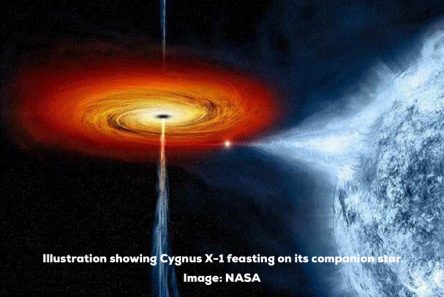 a black hole in the constellation of Cygnus the Swan and Sagittarius A* (pronounced as “Sagittarius A-star), or Sgr A* for short, a giant black hole located at the center of our Milky Way Galaxy. Read on and you’ll learn things like how we discovered them, where to look in the sky in order to find the general direction in which they are located, and some of the weird things that would happen to you should you be so bold, or clumsy, as to fall into one.
a black hole in the constellation of Cygnus the Swan and Sagittarius A* (pronounced as “Sagittarius A-star), or Sgr A* for short, a giant black hole located at the center of our Milky Way Galaxy. Read on and you’ll learn things like how we discovered them, where to look in the sky in order to find the general direction in which they are located, and some of the weird things that would happen to you should you be so bold, or clumsy, as to fall into one.
Today, we know that black holes exist all across our night sky, but Cygnus X-1 is rather special because it is the first confirmed black hole ever found. In 1964 a series of sounding rockets were sent into suborbital flights and carrying a payload of fancy Geiger counters. Those Geiger counters detected an unusually bright source of X-rays located in the direction of the constellation of Cygnus the swan. Astronomers, focusing their telescopes upon this region, found a massive, hot, blue O-type star. This was a bit weird. Even though O-type stars are rather luminous and very powerful, they just don’t crank out light in the X-ray part of the electromagnetic spectrum this brightly. Analysis of the star’s light showed a very strong Doppler shift, indicating that there was something invisible the star was orbiting around every 5.6 days. The only possible thing that could be invisible, emitting X-rays this strongly, and capable of slinging a massive star around it every 5.6 days is a black hole.
A paper published earlier this year indicated that Cygnus X-1 is located 7,200 light years away and weighs in at 21 times the mass of the Sun. That’s big for a stellar mass black hole which form when giant stars run out of fuel within their cores. When that happens, the star can no longer emit the energy needed to keep gravity from crushing it down into something smaller. The star’s outer layers come crashing down onto the core, bounce off, creating a shockwave that blows the outer layers away in a supernova explosion, followed by the core collapsing down into either a neutron star or a black hole. The core’s eventual fate is determined by the progenitor star’s initial mass and how much it lost over the course of its life. The new study indicated that the star that gave birth to Cygnus X-1 must have been a monstrous 60 times as massive as the Sun. Such stars would normally have lost a considerable amount of their mass before dying so accounting for Cygnus X-1’s weight is still a mystery.
Now, about those X-rays. As Cygnus X-1 and its massive stellar companion orbit around one another, the black hole siphons off material from the star and pulls it into a swirling disc around the black hole’s equator. It’s called an “accretion disc” and it is shredded matter that is swirling around the black hole like water about to go down your bathtub drain. Except that this material is spinning at a significant percentage the speed of light. The inner portions of the disc are spinning faster than the outer portions and all of the friction from this motion heats the disc up to the point where it glows in X-rays. Hot, hot, hot! The black hole itself is spinning at some 800 revolutions per second, creating powerful magnetic fields that focus two jets of material outwards along the rotation axis of Cygnus X-1. Can you imagine what a sight that would be! Provided of course you were watching from a very safe distance.
 Kids (and many adults) are curious about what might happen if they were to fall into a black hole and I’m always more than happy to oblige them with all of the gory details. So, let’s say that you were an astronaut and somehow or another, you strayed too close to the black hole, and you got pulled in. It’s not going to be pretty. Let’s also say that you are going in feet first. You would begin to feel a tug on your body of course but the tugging will be stronger at your feet than at your head. That’s because your feet are closer to the gravitational source than your head. At the same time that you are feeling stretched, you will also feel squeezed. The upshot of all this is that tidal forces of Cygnus X-1’s gravity is going to stretch you like taffy. Every. Square. Inch of you, right down to your constituent atoms. You only have to look at what it’s doing to that star in order to get an idea as to what is about to happen to your body. For those of us watching from a safe distance, we would literally see you stretched out into something that looks like spaghetti (and the actual technical term for all this is “spaghettification”). I’d say, send us a post card and tell us what’s on the other side, but you would be dead before you even hit the event horizon.
Kids (and many adults) are curious about what might happen if they were to fall into a black hole and I’m always more than happy to oblige them with all of the gory details. So, let’s say that you were an astronaut and somehow or another, you strayed too close to the black hole, and you got pulled in. It’s not going to be pretty. Let’s also say that you are going in feet first. You would begin to feel a tug on your body of course but the tugging will be stronger at your feet than at your head. That’s because your feet are closer to the gravitational source than your head. At the same time that you are feeling stretched, you will also feel squeezed. The upshot of all this is that tidal forces of Cygnus X-1’s gravity is going to stretch you like taffy. Every. Square. Inch of you, right down to your constituent atoms. You only have to look at what it’s doing to that star in order to get an idea as to what is about to happen to your body. For those of us watching from a safe distance, we would literally see you stretched out into something that looks like spaghetti (and the actual technical term for all this is “spaghettification”). I’d say, send us a post card and tell us what’s on the other side, but you would be dead before you even hit the event horizon.
LOCATING CYGNUS X-1
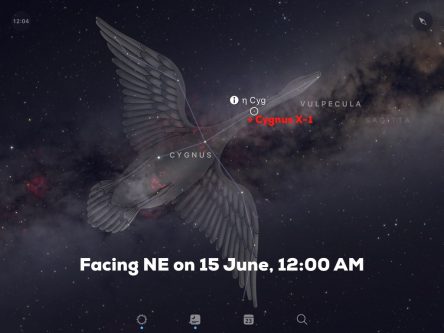 During the month of June, the constellation of Cygnus is best seen around midnight while facing the NE. The swan appears to be flying along the summer Milky Way. It will rise earlier and earlier throughout the summer and will be on display well into the fall. Use a star map or app to locate the familiar pattern of stars that form the Northern Cross asterism. Cygnus X-1 is located about 1/2 a degree away from the star Eta Cygni.
During the month of June, the constellation of Cygnus is best seen around midnight while facing the NE. The swan appears to be flying along the summer Milky Way. It will rise earlier and earlier throughout the summer and will be on display well into the fall. Use a star map or app to locate the familiar pattern of stars that form the Northern Cross asterism. Cygnus X-1 is located about 1/2 a degree away from the star Eta Cygni.
SAGITTARIUS A*
 On average, most stellar mass black holes are anywhere from 3 to 10 solar masses but within the hearts of most galaxies, there are black holes that seem to be on steroids, supermassive black holes. These Godzilla black holes range from millions to billions of solar masses. Holy cow, where did they come from? We don’t know. No star gets so big as to be the progenitor of something that massive. It’s an ongoing area of research in astronomy and we just aren’t sure if they could have arisen from out of the collapse of a massive cloud of gas and dust or if they form by the mergers of smaller black holes or neutron stars (or both). You would think that there would be black holes that are intermediate in mass between stellar mass and supermassive but they seem to be few and far between. Astronomers have been diligently searching for them but have only recently found convincing evidence for their existence. Whatever the solution is to their origins, just know that there is one in the center of our own galaxy that has a mass of 4 million Suns. By comparison, the black hole that was imaged in the galaxy M87 a couple of years ago has a mass of some 6.5 billion Suns.
On average, most stellar mass black holes are anywhere from 3 to 10 solar masses but within the hearts of most galaxies, there are black holes that seem to be on steroids, supermassive black holes. These Godzilla black holes range from millions to billions of solar masses. Holy cow, where did they come from? We don’t know. No star gets so big as to be the progenitor of something that massive. It’s an ongoing area of research in astronomy and we just aren’t sure if they could have arisen from out of the collapse of a massive cloud of gas and dust or if they form by the mergers of smaller black holes or neutron stars (or both). You would think that there would be black holes that are intermediate in mass between stellar mass and supermassive but they seem to be few and far between. Astronomers have been diligently searching for them but have only recently found convincing evidence for their existence. Whatever the solution is to their origins, just know that there is one in the center of our own galaxy that has a mass of 4 million Suns. By comparison, the black hole that was imaged in the galaxy M87 a couple of years ago has a mass of some 6.5 billion Suns.
The idea of supermassive black holes at the center of galaxies was first proposed back in the 1960’s but finding one at the center of the Milky Way Galaxy was problematic due to all the intervening dust and gas that obscures our view towards galactic central. However, by imaging the core of our galaxy at infrared wavelengths, which can penetrate all that gas and dust, astronomer Andrea Ghez  was able to map the orbits of stars that all appeared to be moving around something very compact and invisible. There is nothing we know of in the universe that can slingshot dozens of stars around in their orbits like that except for a supermassive black hole. After many years of painstakingly accumulating data, Andrea provided overwhelming evidence for their existence, something many of her peers and academic advisors over the years told her would be impossible. She won the 2020 Nobel Prize in physics for her efforts. Don’t let others deter you from your goals!
was able to map the orbits of stars that all appeared to be moving around something very compact and invisible. There is nothing we know of in the universe that can slingshot dozens of stars around in their orbits like that except for a supermassive black hole. After many years of painstakingly accumulating data, Andrea provided overwhelming evidence for their existence, something many of her peers and academic advisors over the years told her would be impossible. She won the 2020 Nobel Prize in physics for her efforts. Don’t let others deter you from your goals!
What happens if you fall into a supermassive black hole? Well, it’s still ultimately not good but at least, theoretically, you might live a bit longer than you would falling into a stellar mass black hole. Stellar mass black holes have much stronger tidal forces than does the supermassive variety. Remember when we were talking about escape velocity, and I said that one of the things that determine how powerful the grip of gravity is going to be for any object is how far away you are from the center. Well, with a stellar mass black hole the radial size of the event horizon might be just a couple of miles or less. For a supermassive black hole, that radial size might be 7.3 million miles. Falling into the stellar mass black hole, the tidal forces are going to be much, much stronger because you are allowed to get closer to the center before passing the event horizon, but they are much weaker for a supermassive black hole. The gravitational forces are still going to be powerful enough to pull you in at speeds approaching that of light.  Now, with Einstein’s theory of special relativity, when you travel at such speeds, time will literally slow down for you. This is known as “time dilation”. Einstein also says in his theory of general relativity, that time dilation occurs the closer you are to a gravitational source. It may sound crazy but it’s true. We have to factor in the effects of time dilation in our GPS satellites as they orbit the Earth, if we didn’t all your GPS devices and apps that make use of them would be worthless.
Now, with Einstein’s theory of special relativity, when you travel at such speeds, time will literally slow down for you. This is known as “time dilation”. Einstein also says in his theory of general relativity, that time dilation occurs the closer you are to a gravitational source. It may sound crazy but it’s true. We have to factor in the effects of time dilation in our GPS satellites as they orbit the Earth, if we didn’t all your GPS devices and apps that make use of them would be worthless.
So, as you reach the event horizon, those of us on the outside, would (theoretically) see your image freeze upon its “surface”. To you, you would just go on through but, to our eyes, you appear to be stuck. Eventually, our image of you would get redder and redder as the photons reflecting off of you lose more and more energy. After some time, your image would just fade away. But as you fall inwards, there are things out ahead of you that have been experiencing time dilation for much longer than you have. You would be able to see everything that has fallen into the black hole in the past. Looking behind you, you’ll see everything that ever will fall into the black hole. In essence, you will be able to see both forwards and backwards in time and I’m not sure if that’s just cool or utterly terrifying.
LOCATING SAGITTARIUS, A*
Sgr A* is some 26,000 light years away and its location is hidden by gas and dust but you can get a good idea of the direction in which it lies 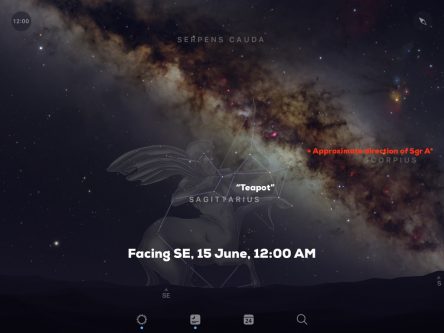 by following the flight of Cygnus the swan along the path of the Milky Way. Near the horizon, locate the asterism known as “The Teapot”, in the constellation of Sagittarius. Just above, and to the right of the teapot’s spout is the direction in which to find galactic central and Sgr A*.
by following the flight of Cygnus the swan along the path of the Milky Way. Near the horizon, locate the asterism known as “The Teapot”, in the constellation of Sagittarius. Just above, and to the right of the teapot’s spout is the direction in which to find galactic central and Sgr A*.
I hope you’ve enjoyed our foray into black holes and that you have learned a bit more about them. If you want to learn where even more black holes are throughout the entire year, then visit the NASA Night Sky Network to find easy to read, printable star maps of their various locations: https://nightsky.jpl.nasa.gov/download-view.cfm?Doc_ID=621
For me, just knowing where black holes are in my night sky fills me with both awe and wonder with the universe.